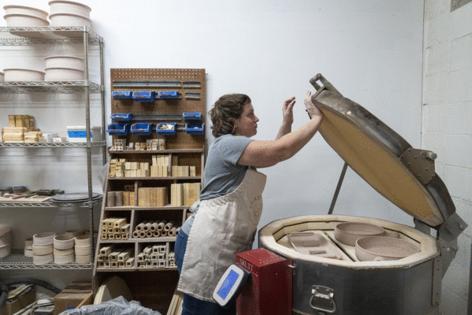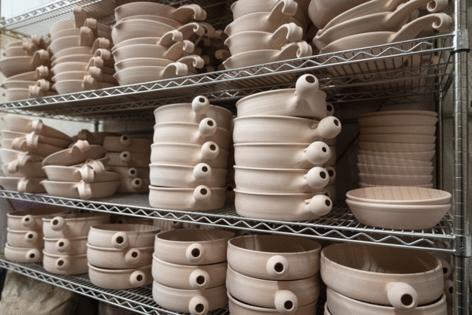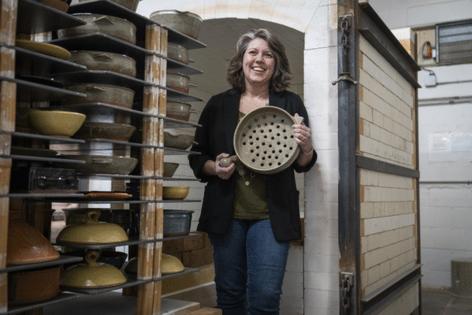Why this clay cookware should be in your kitchen
Published in All About Wine
MINNEAPOLIS — It's fitting that Clay Coyote pottery studio is celebrating its 30th year with a cookbook.
"It's funny because you know how they say cooking is an art and baking is a science? Pottery is both," said Morgan Baum, owner of the studio in Hutchinson, Minnesota.
In the self-published "Cookin' With the Coyotes: Friends in Your Cupboard," Baum pays tribute to the loyal followers who have embraced cooking with clay, while teaching the uninitiated about its cookware. But to really appreciate the cookbook — and how Clay Coyote came to be one of the few studios in the country to produce flameware cookware — a little background is in order.
Clay Coyote started making cookware in 2008, when the studio was owned by Tom Wirt and Betsy Price, Baum's mother. The country was about to embark on a clay cooking movement, thanks in part to the release of Paula Wolfert's seminal "Mediterranean Clay Pot Cooking."
Wolfert was a longtime friend of Clay Coyote, having commissioned several pieces since the 1990s. She issued a challenge that would change the trajectory of their business: to produce flameware, clay cookware that could be used on direct heat, including grills and electric and gas stovetops. (Most other clay cookware is stoneware, and made for indirect, low-and-slow cooking.)
Wirt and Price went to work, seeking counsel from other potters and perfecting their recipe for a proprietary mix of flameware clay and glaze that would expand and contract at the same rate without cracking. It took two years of fine tuning, but now, more than a decade later, Clay Coyote's flameware line consists of everything from saucepans and skillets to casseroles and pizza stones. They're they only studio in the country making clay grill baskets and stovetop tagines.
Making cooking an art form
There are definitely baked-in benefits of cooking with clay, Baum said.
For starters, clay performs differently from other cookware. "It's an insulator, so it holds the heat," she said. "When you're making things like sauces and roux, the properties of the clay spread out that heat so you get a much thicker outcome," making it ideal for dishes like stew.
"There's also an art form to cooking with clay that's so authentic," she said. "It's one of the oldest art forms, and it's incredible to know that we're making something that lasts a lifetime. You go all over the world and some of the most well-known dishes from a region are paired with clay."
Baum also said there's a personal connection because each piece is made by hand. "An artist formed this piece with their hands and now it's in your hands and in your home," she said. "I do think that when people are using clay, they feel a different connection to the piece than if it was just a mass-produced metal pan."
"And it's fun," she said. "We want people to have fun in the kitchen."
That combination of traits led food writer Sylvie Bigar to Clay Coyote.
Bigar went on a yearslong journey writing about cassoulet, the slow-cooked stew from southern France, that culminated in the memoir "Cassoulet Confessions," published in 2022. While in the throes of research, she pulled out another of Wolfert's books, "The Cooking of Southwest France." On its cover was a bright yellow cassole that caught her eye. It reminded her of the vessels she saw in France — and it was made by Clay Coyote.
Bigar reached out to Clay Coyote in late 2021. She and Baum talked about the nuances of cassoulet and cassoles, the pot made specifically for the stew. Bigar preferred a slightly different shape from the one Clay Coyote had been making. "Morgan said, 'Let's try to make your ideal cassole, and when your book comes out, we'll have a cassole to go with 'Cassoulet Confessions.' And I thought that was a fabulous idea," Bigar said.
"I didn't even think that she would be interested in creating something that then would become part of their repertoire," she said. But they did, and now Clay Coyote has two cassoles, one tailored to Bigar's cassoulet recipe, the other to Wolfert's.
A natural progression
That Baum would one day take over Clay Coyote was a given.
"Once we established the business as a family, I always knew I wanted to be a part of it," she said. "I was raised in a pottery family, so pottery is in my blood."
Baum, who has a background in political science, journalism and fundraising, lived on the East Coast for nearly two decades, but remained a constant at Clay Coyote. She took the reins in 2016, when Wirt and Price were ready to retire. She introduced a new marketing style for today's audience and a renewed emphasis on their most popular products. (Price is still the studio manager, and jokingly calls herself the "old coyote.")
"We've really leaned into the story of our cookware over the last decade. I really focused on showing folks how to use the cookware," she said, focusing on cooking classes, videos, public demonstrations and media appearances.
It was a no-brainer, Baum said, to release the cookbook, an update of one published in 2006. Recipes come from Baum and host of others — family, friends and fellow Coyotes. The book also offers a primer of the studio's history and how the pottery goes from clay to kitchens. It's a testament to Baum's hard work, both in the kitchen and introducing Clay Coyote to the next generation.
"People cook differently, they engage differently online, people like to watch short videos on how to cook. All of those external forces were happening at the same time I took over, so I just leaned into it all," she said. "And then you throw a pandemic in the mix where everybody all of a sudden is cooking at home again."
The pandemic was a game-changer for Clay Coyote. Bread bakers flew out the door, packaged with hard-to-find packets of yeast that Baum and her mom bought at a local grocery store. They introduced the pizza stone, a product that customers had been requesting for years.
Adding pieces to the flameware line isn't done lightly. Baum has to calculate the cost of materials and labor for each handmade piece, and whether the final result will be at a price point customers will pay. Still, new pieces are coming. Next up, again by customer demand, are teapots, which will be available this spring.
"Customers are asking for it, but teapots have so many components. It's got a base, it's got a handle, it's got a spout, it's got a lid — that's a lot of work. And it's not very big," she said. "But you know? Good things come in small packages."
Learning on the job
In addition to a pottery studio and gallery, Clay Coyote is also a small business incubator, where artists can launch their pottery careers while working in the studio.
"They can do that while they work here, simultaneously, or we could be a springboard to their future," Baum said. "I believe that a high tide lifts all boats. The more potters in our community, the better."
Part of artists' perks include buying clay at cost, using the kilns, discounts on shipping, and an environment that allows potters to take a piece from start to finish, which, Baum said, makes them better artists. That hasn't gone unnoticed.
"They're so supportive here," said Mallory Keating, one of seven Clay Coyote potters. "And they really emphasize quality over quantity, and you can be part of a process that you're proud of."
"Our goal is to help launch the next generation of potters," Baum said. "We're celebrating 30 years, but my parents handed the torch to me, and I'm handing the torch to the next generation."
Chicken Tagine with Preserved Lemons, Olives and Thyme
Serves 4 to 6.
From "Cookin' With the Coyotes," by Morgan Baum, who writes: "On our honeymoon we rented a car and drove more than 700 miles over three weeks across western and central Morocco. We traveled to the Atlas Mountains and took a tagine cooking class in the middle of nowhere, and we spent a night in Mirleft, where we had the single best meal of my life. Morocco was a food lover's paradise, the culture was captivating, the people were kind, and the scenery was spectacular. I've said, 'I left my heart in Morocco,' but that's not true. I carry the experiences of that trip with me every day and I'm a better person because of it."
• 1 clove garlic
• 1 tsp. paprika
• 1/2 tsp. ground ginger
• 1/4 tsp. turmeric
• 1/4 tsp. ground cumin
• 1/4 tsp. kosher salt
• 1/4 tsp. freshly ground black pepper
• 2 tbsp. olive oil
• 6 to 8 bone-in, skin-on chicken thighs
• 1 preserved lemon (or 1 tablespoon preserved lemon paste)
• 1 c. green olives, with pits
• 1 tbsp. chopped thyme, divided
• 1/2 c. chicken broth
• Couscous, for serving
Directions
Make the spice mixture by combining together garlic, paprika, ground ginger, turmeric, cumin, salt and freshly ground black pepper. Add olive oil slowly while stirring.
Coat the chicken thighs in the spice mix.
Place tagine (or a Dutch oven with a tight-fitting lid) on stove over medium-high heat. Transfer the chicken to the tagine, skin-side down, and sear for 1 to 2 minutes. Turn the chicken over and add in the preserved lemons, olives, thyme, and chicken broth.
Cover and turn the heat to low and cook for 45 to 55 minutes. Cook with the cover on, mixing once along the way to ensure the chicken isn't sticking.
Serve hot over couscous.
Barbara's Egg Strata
Serves 6 to 8.
From "Cookin' With the Coyotes: Friends in Your Cupboard," by Morgan Baum, who writes: "Each year, the night before Christmas, we make this strata so we can put it in the oven in the morning. We all chip in and throw this together, it's a family affair. Now, I share this recipe verbally almost daily at the Gallery. The first time we made it we followed the recipe from Deb Perelman in 'Smitten Kitchen,' but over the years it has been modified with local ingredients. I used our Clay Coyote Flameware Cazuela so I could start it on the stove and finish it in the oven. I really dislike soggy bread. It's one of my many endearing quirks. But I love this dish." This recipe must be made in advance.
• Olive oil
• 1/2 onion, diced
• 8 oz. frozen spinach, thawed and drained
• 1 c. breakfast meat, such as bacon, ham or sausage, optional
• 8 to 10 eggs beaten
• 1 c. milk or cream
• 1 tbsp. Dijon mustard
• Salt and freshly ground pepper, to taste
• 2 c. day-old bread, cubed
• 8 oz. shredded cheese, such as gruyère or fontina, optional
Directions
Heat oil in a pan over medium-high heat. Add onions, spinach and meat, if using, and sauté until onions are tender and the meat is mostly cooked.
In a medium bowl, beat together eggs, milk, mustard and salt and pepper. Set aside.
In a deep baking dish, spread cubed bread throughout and top with spinach, onion and meat mixture. Pour egg mixture over, making sure to cover all the bread pieces, and top with cheese, if using. Cover tightly and refrigerate at least an hour, preferably overnight.
When ready to bake, remove strata from refrigerator and allow to come to room temperature and place in a cool oven and bring up to 350 degrees. Bake for 60 to 75 minutes, until the top is lightly browned and the center doesn't jiggle much. (If using a thermometer to check doneness, the internal temperature should read 160 degrees.) Remove from oven and let it set for at least 10 minutes before serving.
Wild Rice Soup
Serves 4 to 6.
There are a lot of great versions of this quintessential Minnesotan soup, but this recipe, from Ruth Wirt, the mother of co-founder Tom Wirt, is the best, said Morgan Baum in "Cookin' With the Coyotes." "Ruth was a total rock star and just a fiery human, and her soup is pure comfort. She worked at the U of M cafeteria for 40 years, so everybody who came through knew her and her food." You can sub turkey, or you can skip the meat and use a vegetable broth to make it vegetarian. But the rest of this recipe is perfect, don't change a thing, Baum says.
• 6 tbsp. butter
• 1 tbsp. minced onion
• 1/2 c. flour
• 2 1/2 c. chicken broth
• 2 c. cooked wild rice
• 2 c. cubed chicken
• 1/2 c. grated carrots
• 3 tbsp. chopped almonds
• Salt, to taste
• 1 (12-oz.) can fat-free evaporated milk
• 2 tbsp. dry sherry
• Minced parsley or chives
Directions
In a large Dutch oven over medium-high heat, melt butter. Add onion and sauté until translucent. Add flour and stir until thickened. Whisk in broth, and continue to whisk until the mixture comes to a boil. Once boiling, continue to cook for another minute.
Add wild rice, chicken, carrots, almonds and salt; simmer for 5 minutes.
Whisk in evaporated milk and sherry, and stir until heated through. Garnish with parsley or chives before serving.
____
What you should know about Clay Coyote
The gallery: 22 1st Av. NE., Hutchinson, Minn., 320-587-2599, claycoyote.com. The building houses both the studio and a gallery, which in addition to Clay Coyote pieces, sells works from other artists that owner Morgan Baum curates. The new cookbook, "Cookin' with the Coyotes: Friends in Your Cupboard," is available on the website for $32.99.
Clay cooking 101: The glaze on the pottery makes it naturally nonstick for easy cleanup. Clay Coyote sells about 7,000 pieces a year, which include items, like cassoles, that aren't flameware. Prices for flameware range from $45 for a small pie dish to $215 for a 3-quart Dutch oven; its most versatile piece, the cazuela, is $125. The company also sells complete sets of dishes, mixing bowls, trays and more.
Most of the flameware doesn't have lids. The Dutch oven and tagine are the only pieces with matching lids. "If we were to make a lid for every pot, it would more than double the price because it's a whole separate piece," Baum said. She recommends using a BPA-free silicone lid; they fit on all the pieces.
An exercise in frustration: The bestselling grill basket came about because founder Tom Wirt was gifted a metal grill pan for Christmas, and "it burned everything, because metal conducts heat," Baum said. Wirt and Price headed to the studio and punched holes in one of their flameware pieces in progress. "It worked, and it worked really well because the heat from the grill was spread out but you still got the flames through the holes," Baum said.
A Super opportunity: In 2017, Clay Coyote's grill basket was selected by the NFL to be part of the Super Bowl LII Business Connect Program. Baum went through a "Shark Tank"-esque pitch. "I was standing there with my grill basket and said 'This is good for football' and they bought it." They made more than 300 commemorative baskets, replacing the Clay Coyote logo with the Super Bowl logo. "It got us on the map for the grill basket."
©2024 StarTribune. Visit at startribune.com. Distributed by Tribune Content Agency, LLC.












Comments